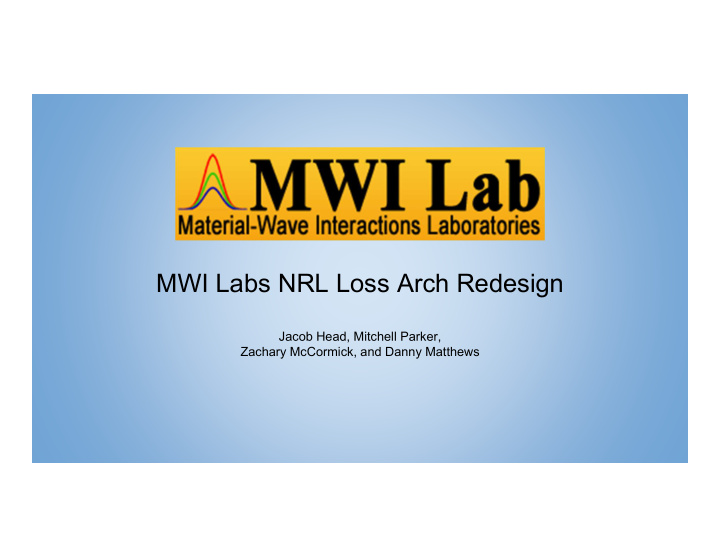



MWI Labs NRL Loss Arch Redesign Jacob Head, Mitchell Parker, Zachary McCormick, and Danny Matthews
Client Description Client: Mr. Jeff Peebles of Material Wave Interactions Laboratories (MWI) - Began as a subsidiary of ASU’s engineering program - Analyze radio frequency absorbing (RF) materials using electromagnetic radiation - Rents devices to third party military contractors
History of Navy Research Lab (NRL) Arch - Proposed by Thomas Edison and was first developed on July 2, 1923 - Primary Function: repeatable, non-destructive testing of microwave absorbent materials over a wide frequency range Fig. 1: NRL Arch located at the National Synchotron Light Source [1]
Importance of NRL Arch Technology - Testing material with a high capacity for reflecting EM radiation necessary for military applications - Allows for the construction of airplanes, foils, and other military supplies that are invisible or resistant to radar - Protects vital resources and personnel - Non - destructive testing equipment
Project Description - Original device uses gaussian beams (a type of EM radiation) to bounce waves off of material and observe the response - Mainly used to test for military applications - Primary concern of client is the reduction of harmonic vibration in the NRL Arch arms - Current system requires intensive human interaction to set up and test Fig. 2: Original Design [2] Danny Matthews 4/19/18 1
Video of Previous Model’s Vibrations
Customer and Engineering Requirements Customer Requests Engineering Interpretation Eliminate or reduce harmonic vibrations in the Observable response should reduce amplitude to arms of the NRL Arch redesign a steady rate close to zero within two to three minutes of disturbance A new control system needed to be implemented A motor control system with associated GUI was to replace the guide wires and hand crank--GUI needed to provide the arms with motion should require as little human intervention as possible Increase the portability of the device Device is to come in no more than 4 pieces, and customer should be able to assemble it within 4 to 6 hours Device must meet CE (Certified European) safety NRL Arch arms must be able to withstand three standards times the expected load supplied by the antennae Danny Matthews 4/19/18 2
Generation Three Prototype Based on the customer and engineering requirements, a prototype was developed The prototype included the following changes: - Arm material was changed to 1010 HR Steel - The arm geometry was changed - A motor driven system was devised - Frame integrity was improved Jacob Head 4/19/18 5
Arms reinforced with trusses for stability. Arms each driven Not pictured: Antennae. separately by a motor operated electronically to reduce user interference. Extended rear for increased stability, permits independent operation of arms. Danny Matthews Fig. 3: Detailed Layout of Final 4/19/18 Prototype Design 6
Testing The following methods were used to test the effectiveness of the device’s redesigns - Frequency Analysis - Deflection Analysis via FEA - Testing of motor control systems Zachary McCormick 4/19/18 7
Frequency Analysis - Arduino-Based Data Collection - Data obtained using an MPU-6050 Accelerometer - Measure the amount of time until vibration stops - This data is then compared to the theoretical data based on the changes in arm material Figure 5: Genuino Uno Zachary C. McCormick Board, Attached For 4/19/2018 Figure 4: MPU-6050 8 Testing Accelerometer
Frequency Analysis Results - Behavior of vibrations, seen right in Fig. 6 - Vibrations return to constant amplitude after one second Fig. 6: Plot of Frequency vs. Time
Deflection Analysis Fig. 7: Deflection FEA Maximum Al deflection: 0.37” Danny Matthews Maximum Steel deflection: 0.059” 4/19/18 9
Portability Condition - High-weight capable caster wheels - Integration of arms and table Jacob Head 4/19/18 10 Figure 8: Rear-end Integrated Assembly
Motor Controlled Systems - 19V Power Source - NEMA 23 Motor - 5.6A Max Current - With Stepper Current, 1.2V - Arduino Controlled - Torque: 286 oz. inch or 1.49 ft. lb. - 29.8 lb ft. with 20:1 Gearbox - T6600 Microstep Driver - Applies 3.0A Fig. 9: Graphical User Interface (GUI) Mitchell Parker 4/19/18 11
Motor Control Mitchell Parker Fig. 10: Belt-Driven Motor System 4/19/18 12
Motor Control Hardware Fig. 11: Arduino Communication Setup
Final Design Details Selected Material and Geometry: - Arm material selected is 1010 HR Steel due to its availability. - Trusses/cantilevered beams composed of 15 series 8020 Aluminum due to weight restrictions - Customer Request Final Design is a Gen III Design - Ultimately reduces risk for client and user in future production - Multiple generations for Prototyping (Gen I, III, V, etc.) - Capstone NRL Arch is a Generation III Prototype Jacob Head 4/19/18 13
Knowledge and Skills Gained - Learned the importance of NRL Arch technology - Insight into prototyping process in industry - Iterative generations - Risk-management - Learned new skill - Programming - Finite element analysis software (SolidWorks) - Teamwork and Communication Skills
Conclusion Metric for Goals Accomplished - Primary goal: Reduction in Harmonic Vibrations - Success - Secondary Goal: Motor-Driven Arms - Did Not Succeed - Secondary Goal: Device Meeting CE Standards - Success - Tertiary Goal: Increased mobility - Success Reasons for successes and lack of success...
Conclusions Capstone NRL Arch is Gen III prototype for the first mobile NRL Arch design Suggestions for future iterations: - Lighter and cheaper material for the arms - Decrease steel arm length to avoid interference - Recommended 90 degree gearbox to save space - Recommended risk assessment to be performed
Acknowledgments Jeff Peebles Ron and Larry Frey Mike Balor Dr. David Trevas Amy Swartz Alarick Reiboldt
References [1] Tms.org. (2018). The Naval Research Laboratory: 75 Years of Materials Innovation. [online] Available at: http://www.tms.org/pubs/journals/jom/9807/rath-9807.html [Accessed 25 Apr. 2018] [2]
Questions?
Recommend
More recommend